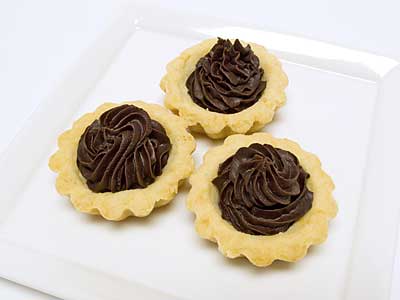February 4, 2013
Mignardise

petits tartes au ganache
(ganache-filled tarts)
Ganache is a perfect food both in taste and texture. Made with good chocolate and good cream, it can be appreciated without any other flavors or combined with other ingredients for a different sensation. It can cover the top of a cake or reside hidden in a robe of tempered chocolate and still work its magic.
I first encountered ganache at a demonstration of chocolate-truffle making presented at the offices of Sunset Magazine in Menlo Park, California. Even though this was the early 1990s, the Sunset attitude that women cook and men just barbecue was well in force. There was about 50 people in the audience of which I was the only unaccompanied male. There were a few elderly husbands dragged to the presentation. The woman doing the demonstration, one of Sunset’s resident recipe testers, kept making references of how the making of ganache was only for women. Her attitude was not a surprise. When I submitted an original recipe in 1976 and it was accepted for printing in the magazine, it was sequestered with all the other recipes submitted by men in a section called “Chefs of the West.” About that same time I took a tour of the facilities, and was informed that men were never serious cooks because they were not the ones raising the family. As a single parent I took exception, but they also indicated that male single parents were inappropriate.
The ganache demonstration was pretty straight forward and quick. A bowl of chopped chocolate was brought to the demonstration table from a kitchen behind a door in the front wall. Then a saucepan of cream was brought out and poured over the chocolate. The cream was described as being just off the stove after having been brought to a boil. The demonstrator then struggled to combine the two into the soft mass we know as ganache. She was obviously afraid of burning herself, so until a helpful potholder-covered set of hands came forward to hold the bowl, it continued to spin on the table at the same speed as the whisk while she attempted to combine the bowl’s contents.
Eventually the failed batch was removed to the kitchen, and a cooled, finished batch was produced to take its place. The demonstrator used a spoon to lift out portions of the ganache and hand to an assistant. The assistant rolled each into a ball and dropped it into some cocoa powder. After a few were made in this manner, these bowls were removed to the back and a tray of finished truffles were produced for all to try. My memory is that they tasted very smooth, a bit too sweet, and were too small. I decided to leave before the next demonstration because I was tired of it being implied that I didn’t belong there.
After that, I didn’t bother to try the Sunset truffle recipe or even make ganache. I just wasn’t in the mood. The mood wouldn’t strike until I had completed a stage in 2001 at the Auberge du Schœnbourg in Riquewihr, France, where I had helped to make about a thousand truffles one afternoon.
It’s hard to believe that ganache is a rather recent creation and not one from the dark past. The word ganache was apparently used in print for the first time in 1905 on page 199 of Duval’s Traité général de confiserie moderne. Prior to that it may have been called something else or maybe didn’t exist in the form we know it today. Duval’s concoction was a simple combination of vanilla-flavored cream and chocolate in a one to three ratio. I tend to use a mixture ratio closer to one to one (because that is what I was taught). Many of the professional recipes I see are closer to one to two.
The recipe I use for ganache is courtesy of Yves Thuriés and came from the back of a box of pistoles sold as chocolat dessert noir à pâtissier. The ratio of chocolate to fat is fine for making truffles, but it can be a bit low for other uses. My biggest “problem” when making ganache is that I tend to have a lot left over. No matter what I’m making, it is usually in small quantities, and ganache likes to be made with a more reasonable quantity of ingredients. So I often have to find something to do with the excess ganache—other than snack on it—which I will do a bit anyway.
One day when my ganache runneth over, I also found myself with an excess of pâte d’amandes (almond-based tart crust). It was a simple matter to press the dough into mini-tart pans and bake them at 180 °C (355 °F) until slightly browned. The doughes rose a bit in baking, so I pressed them down in their pans with a small, wooden dowel while they were hot out of the oven. Once cool, I piped the ganache into the shells using a small star tip. I left the tarts in the pans until I put them on the mignardise plate so their crusts wouldn’t fracture.
The final result of the smooth, almost unctuous, ganache in the crisp tart crust was both a nice flavor and texture contrast. I encouraged my guests to eat then in a single bite to get the best enjoyment.
© 2013 Peter Hertzmann. All rights reserved.
